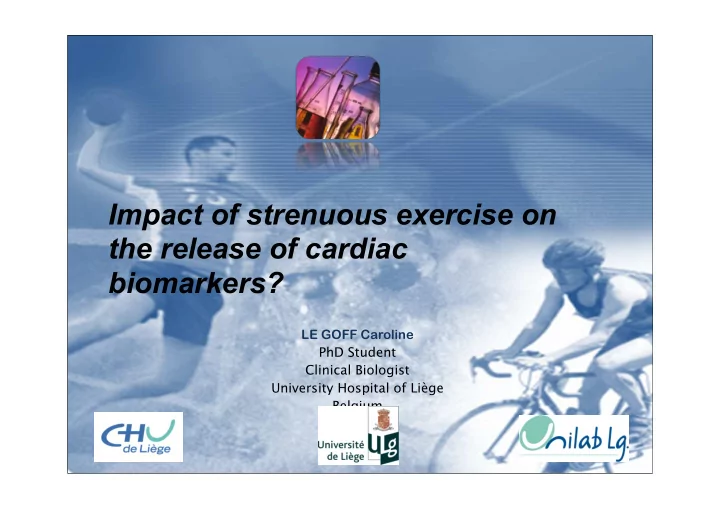

Impact of strenuous exercise on the release of cardiac biomarkers? LE GOFF Caroline PhD Student Clinical Biologist University Hospital of Liège Belgium
Background • Cardiovascular diseases (CVD) represent the leading cause of death in the United States, as well as in numerous developed countries, ahead of cancers and accidents • The risk of cardiac events or sudden death after a vigorous physical e fg ort has been described • The death incidence linked to physical exercise is more important among elderly people than among younger ones and among persons who do not practise regular physical activity • These undesirable events occur following a coronary
Background • Cardiac troponins (T and I)(cTnT and cTnI) are considered as the best biomarkers for detection of myocardial cell injury and NT-proBNP as the best for the cardiac insu ffj ciency. • In this study, cTnT was measured by new commercially available high-sensitive methods in subjects undergoing the Maasmarathon.
Aim • To compare cTnT and NT-proBNP levels before and after the stress test, in runners.
Materials and methods • 28 subjects (26 ♂ , 42.5±11yo) race of 42.195 kilometers between Visé (Belgium) and Maastricht (The Netherlands). • Performance = 4h06±35 min • Blood samples – before =T0 – just after=T1 the race – 3 hours after=T3
Materials and methods • cTnT concentrations were measured by high sensitive methods (hsTnT, Roche Diagnostics) on heparin plasma. • NT-proBNP level was also determined with the kit from Roche Diagnostics on heparin plasma. • The protocol was approved by the ethic committee of the University of Liège (Belgium). All subjects gave their informed consent.
Results
Results p<0.0001 ns p<0.0001 Decision limit 0.014 µ g/L
Results p<0.0001 ns p<0.0001 Decision limit 103 pg/ml
Results Comparison between different races for TnThs
Results Comparison between different races for NT-proBNP
Conclusions • Measurement of cardiac troponins by high sensitive methods enables the detection of a significant release of biomarkers from the heart during exercise. • The value of NT-proBNP are also significant but less than TnThs. • We think that the TnThs could be an interesting tool in the future to help sport medicine to detect risk of developing a
Conclusions • Measurement of cardiac troponins by high sensitive methods enables the detection of a significant release of biomarkers from the heart during exercise. • The value of NT-proBNP are also significant but less than TnThs. • We think that the TnThs could be an interesting tool in the future to help sport medicine to detect risk of developing a
Thank you very much for your
16
Recommend
More recommend